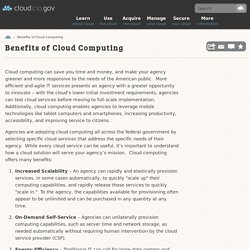

5 Ways Students Can Use Cloud Computing to Amp Up Their Learning. Technology’s greatest power is in its ability to break down barriers of geography, time, and hierarchy.

And the capabilities of the cloud ensure that your students can use technology to get the information and access they need, no matter where they are or what time they are working. Google+ Hangouts for Group Meetings It can be a real challenge to get a group of students together to plan for a collaborative project, especially if they don’t all live on campus or if some of them work. Rather than making a time to meet at a central location, students can set a time that they can all agree to be in an Internet-capable place and communicate on a Google Plus Hangout. They can even record the sessions to refer back to later — who doesn’t need a little help remembering exactly what they agreed to do? Evernote for Anytime Access to Class and Study Notes Evernote is a time-tested and beloved tool for educators and students alike. TED Talks for Access to Cutting-Edge Ideas Jennifer Roland.
The Fine Print on Cloud Computing. (Egan Library link) Cloud computing for education: A new dawn? <div class="msgBox" style="margin-top:10px;"><span class="errMsg"><div>JavaScript is disabled on your browser.

Please enable JavaScript to use all the features on this page. This page uses JavaScript to progressively load the article content as a user scrolls. Click the View full text link to bypass dynamically loaded article content. <a rel="nofollow" href=" full text</a></div></span></div><br /> Nabil Sultan, Author Vitae Faculty of Business and Computer Science, Liverpool Hope University, Hope Park, Liverpool, L16 9JD, UK Available online 23 October 2009. What Every CEO Needs to Know About the Cloud. In 2010 an IBM survey of more than 1,500 CEOs worldwide revealed a troubling gap: Close to 80% of them believed their environment would grow much more complex in the coming years, but fewer than half thought their companies were well equipped to deal with this shift.

The survey team called it “the largest leadership challenge identified in eight years of research.” Unfortunately, the information technology infrastructure at many large companies only makes this challenge more difficult. Their technology environments actually impede their ability to sense change and respond quickly. While there is no simple fix for this problem, help is at hand in the form of cloud computing, a new suite of digital tools and approaches. Benefits of Cloud Computing. Cloud computing can save you time and money, and make your agency greener and more responsive to the needs of the American public.

More efficient and agile IT services presents an agency with a greater opportunity to innovate – with the cloud’s lower initial investment requirements, agencies can test cloud services before moving to full-scale implementation. Additionally, cloud computing enables agencies to leverage mobile technologies like tablet computers and smartphones, increasing productivity, accessibility, and improving service to citizens. Agencies are adopting cloud computing all across the federal government by selecting specific cloud services that address the specific needs of their agency. While every cloud service can be useful, it’s important to understand how a cloud solution will serve your agency’s mission. 10 Benefits of Cloud Computing. Advantages and Disadvantages of Cloud Computing - Cloud computing pros and cons. Introduction Cloud computing refers to the use of computing resources, those being hardware and/or software) that reside on a remote machine and are delivered to the end user as a service over a network, with the most prevalent example being the internet.

The pros and cons of cloud computing. Every place you look, you read about cloud computing.

It’s coming. It’s here. You need it. If you don’t take advantage of it, you could be left behind. Some folks believe it’s the future. Others look at it as part of the information technology circle of life—a fad that will eventually go away. Is the hype valid? As I was thinking about this, I thought it would be useful to put together my view of the pros and cons of cloud computing. The benefits of cloud computing Cloud computing allows you to focus more on your business and not on managing data centers. Managing data centers is not the core focus of most businesses. You can develop new applications faster. By leveraging platform as a service (PaaS), your company will be able to imagine a product or new application, provision the infrastructure and develop the new application much quicker than they ever have been able to do in the past.